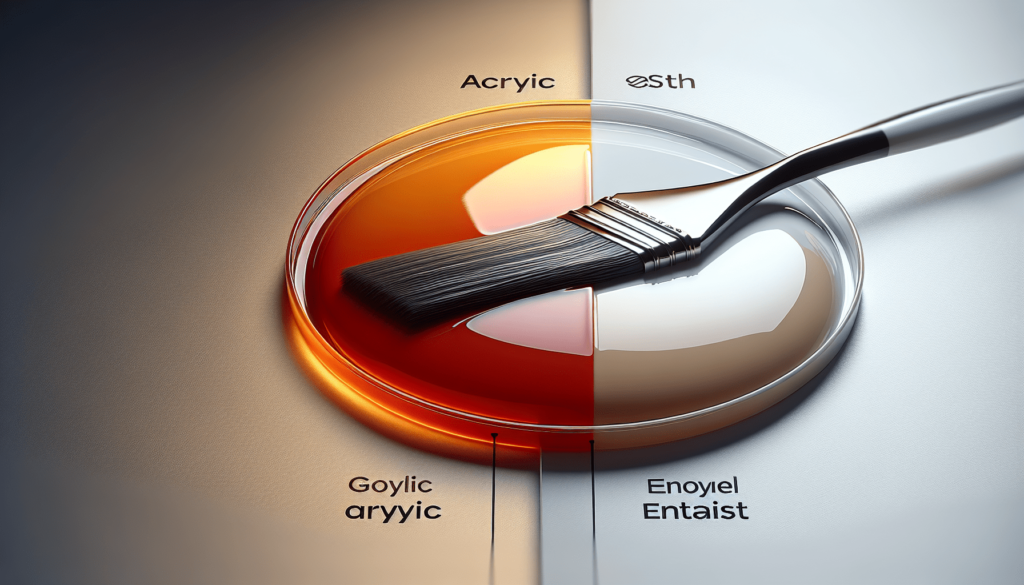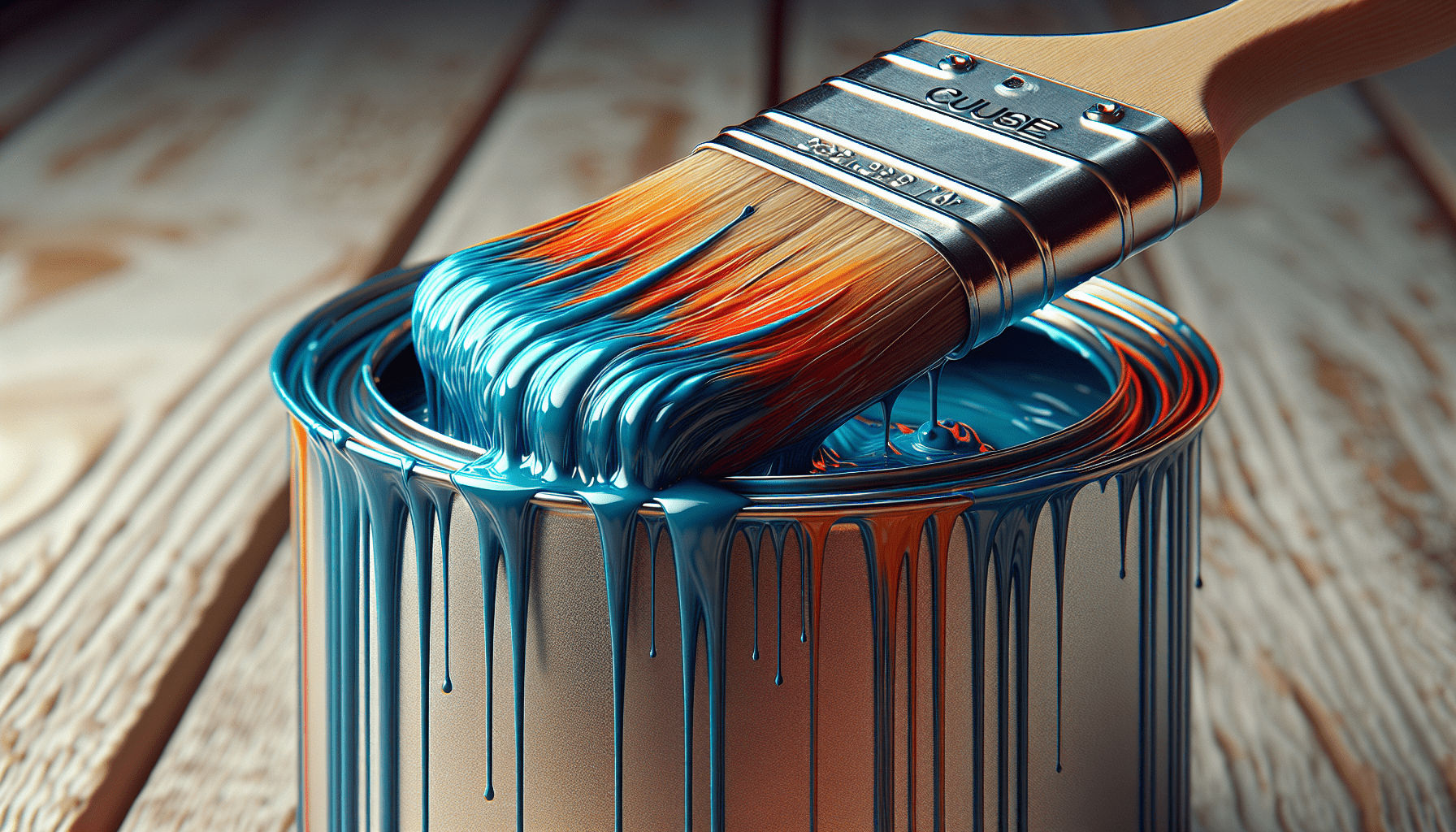When it comes to combining different types of paints, such as acrylic and enamel, it is important to understand the compatibility between the two. This article explores the question, “Can you paint acrylic over enamel paint?” By examining the characteristics of each paint type and considering the necessary preparations, this article provides valuable insights for those seeking to achieve a successful and durable finish when using acrylic over enamel paint.

Understanding Acrylic and Enamel Paints
Acrylic and enamel paints are both popular choices for painting projects, but they have different characteristics and properties. Understanding these paints can help you determine the best approach for your next project.
What is acrylic paint?
Acrylic paint is a water-based paint that consists of pigment particles suspended in an acrylic polymer emulsion. It is known for its quick drying time, versatility, and vibrant colors. Acrylic paint is available in various forms, including tubes, bottles, and jars, and can be thinned with water or acrylic mediums.
What is enamel paint?
Enamel paint, on the other hand, is an oil-based paint that contains pigments, additives, and a varnish-like binder. It produces a hard and glossy finish when it dries and is often used for surfaces that require increased durability, such as metal, wood, and ceramic. Enamel paint is commonly available in cans and can be thinned with specific solvents or thinners.
Compatibility of Acrylic and Enamel Paints
One common question is whether acrylic paint can be used over enamel paint or vice versa. While it is generally not recommended to mix these two types of paint directly, there are some factors to consider for compatibility.
Can acrylic paint be used over enamel paint?
Painting acrylic over enamel is possible, but it requires proper surface preparation and application techniques. The key is to ensure that the enamel surface is clean, sanded, and primed before applying the acrylic paint. This helps create adhesion between the two layers and prevents peeling or cracking in the future.
Can enamel paint be used over acrylic paint?
Enamel paint can be used over acrylic paint, but the acrylic surface needs to be scuffed to create a rough surface for better adhesion. Additionally, applying a proper top coat after the enamel paint has dried is crucial for protection, as enamel is known to be more durable and resistant to wear than acrylic.
What are the factors to consider for compatibility?
Compatibility between acrylic and enamel paints depends on several factors. These include the type of surface, the condition of the existing paint, the application method, and the desired finish. It is important to consider these factors and test compatibility on a small area before proceeding with a larger project.
Preparing the Surface
Properly preparing the surface is essential for achieving good adhesion and a long-lasting finish. When working with acrylic or enamel paints, the following steps should be taken into consideration:
Cleaning the surface
Before applying any paint, it is crucial to ensure that the surface is clean and free from dust, dirt, grease, and other contaminants. Use a mild detergent and water solution or a suitable cleaner to thoroughly clean the surface and allow it to dry completely before proceeding.
Sanding the enamel paint
When painting acrylic over enamel, the enamel surface should be lightly sanded to create a slightly rough texture. This provides a better surface for the acrylic paint to adhere to. Use a fine-grit sandpaper or sanding block and sand the enamel surface gently. Be cautious not to sand too aggressively, as it may damage the surface.
Priming the surface
Priming the surface before applying the paint is crucial for enhancing adhesion and promoting an even finish. Choose a suitable primer based on the type of surface and the paints you are using. Apply the primer according to the manufacturer’s instructions and allow it to dry completely before proceeding with the painting process.
Using Acrylic Paint over Enamel Paint
When using acrylic paint over enamel, following the proper steps can help ensure a successful outcome. Consider the following:
Applying a base coat
Before applying the acrylic paint, it is recommended to apply a base coat of primer or a suitable acrylic paint color that matches the desired final color. This allows for better coverage and color accuracy and helps prevent the enamel color from bleeding through.
Applying thin layers of acrylic paint
To achieve a smooth and even finish, it is advisable to apply thin layers of acrylic paint rather than thick coats. This allows each layer to dry properly and minimizes the risk of cracking or peeling. Use a brush, roller, or airbrush technique depending on the project requirements.
Allowing proper drying and curing time
After applying the acrylic paint, it is important to allow sufficient drying and curing time before applying additional coats or handling the painted surface. Follow the manufacturer’s instructions regarding drying times, as they may vary depending on factors such as humidity and temperature.

Using Enamel Paint over Acrylic Paint
When using enamel paint over acrylic, certain steps should be followed to achieve the best results. Consider the following:
Scuffing the acrylic paint surface
To enhance adhesion, scuffing the surface of the acrylic paint is necessary. Use fine-grit sandpaper or a sanding block to create a rough texture that will improve the bond between the two paints. Gently sand the acrylic surface, being careful not to damage the underlying layers.
Applying enamel paint
Once the acrylic surface has been scuffed, apply the enamel paint according to the manufacturer’s instructions. Use a brush or spray technique depending on the project requirements. Apply thin, even coats, allowing each coat to dry before applying the next one.
Using a proper top coat for protection
To protect the enamel paint and ensure its durability, it is crucial to apply a suitable top coat. This can be a clear enamel or varnish that is compatible with both the enamel and acrylic paints. Allow the enamel paint to dry fully before applying the top coat and follow the manufacturer’s instructions for drying and curing times.
Advantages and Disadvantages
Acrylic and enamel paints have their own set of advantages and disadvantages, depending on the project requirements and personal preferences.
Advantages of using acrylic over enamel
- Quick drying time allows for faster completion of projects.
- Water-based formula makes cleanup easier.
- Offers a wide range of color options and can be easily mixed to create custom shades.
- Suitable for various surfaces, including canvas, paper, wood, and plastic.
- Can be thinned and used as a wash or glaze for translucent effects.
Advantages of using enamel over acrylic
- Produces a hard and glossy finish, providing increased durability and resistance to wear.
- Ideal for surfaces that require superior protection, such as metal, wood, and ceramic.
- Allows for easy touch-ups and repairs due to its ability to blend seamlessly.
Disadvantages of using acrylic over enamel
- Not as durable or resistant to wear as enamel paint.
- May require a protective top coat for increased durability.
- Can be less forgiving when it comes to mistakes or inconsistencies in application.
Disadvantages of using enamel over acrylic
- Longer drying times compared to acrylic paint.
- Requires proper ventilation due to the use of oil-based solvents.
- Cleanup requires specific paints thinners or solvents and can be more challenging.
Tips and Recommendations
To ensure a successful and satisfying painting experience when working with acrylic and enamel paints, consider the following tips and recommendations:
Test compatibility on a small area
Before starting a larger project, it is always advisable to test the compatibility of the paints on a small, inconspicuous area. This will help determine if any issues arise, such as adhesion problems or color bleeding.
Choose high-quality paints
Investing in high-quality acrylic and enamel paints is essential for achieving the desired results. These paints tend to offer better pigmentation, adhesion, and durability compared to lower-quality alternatives.
Follow proper application techniques
Proper application techniques, such as applying thin and even coats, using the correct brushes or tools, and allowing sufficient drying and curing time, are essential for a professional-looking finish. Follow the manufacturer’s instructions and recommendations for best results.
Consider the type of project and desired finish
The type of project and the desired finish should guide your choice between acrylic and enamel paints. Consider factors such as the surface material, durability requirements, color vibrancy, and handling or display conditions when making your decision.
Common Questions and Myths
Let’s address some common questions and debunk a few myths surrounding the use of acrylic and enamel paints together.
Can you mix acrylic and enamel paints together?
While it is generally not recommended to mix these two types of paint directly, it is possible to use them together in certain techniques, such as layering, blending, or creating textured effects. However, always ensure proper surface preparation and compatibility testing when combining different types of paints.
Can you apply acrylic clear coat over enamel paint?
Yes, you can apply an acrylic clear coat over enamel paint. The clear coat provides added protection and enhances the appearance of the enamel finish. Ensure the enamel paint is completely dry before applying the clear coat, and always follow the manufacturer’s instructions for drying and curing times.
Does the order of application matter?
Yes, the order of application does matter when using acrylic and enamel paints together. It is generally recommended to apply enamel paint over acrylic paint. This allows for better adhesion and protection, as enamel paint is more durable and resistant to wear than acrylic. However, proper surface preparation and compatibility testing are crucial regardless of the order of application.
Conclusion
Understanding the compatibility of acrylic and enamel paints is essential for achieving the desired results in your painting projects. By considering the characteristics of each paint, properly preparing the surface, and following the recommended techniques, you can confidently use acrylic over enamel or enamel over acrylic. Assessing the advantages and disadvantages, as well as following the provided tips and recommendations, will help you achieve a professional-looking finish and enjoy the process of working with these versatile paints.



